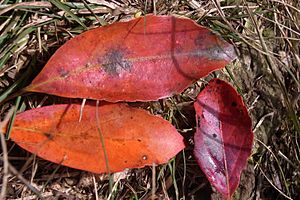Elaeocarpus costatus facts for kids
Quick facts for kids Elaeocarpus costatus |
|
|---|---|
 |
|
| Senescent leaves | |
| Scientific classification | |
| Genus: |
Elaeocarpus
|
| Species: |
costatus
|
Elaeocarpus costatus is a special kind of flowering plant. It's a tree that belongs to the Elaeocarpaceae family. This tree is found only in one place in the world: Lord Howe Island. Because it grows only there, we say it is endemic to that island. It's known for its unique leaves, pretty flowers, and blue fruit.
Contents
What Does Elaeocarpus costatus Look Like?
This tree usually grows to be about 8 meters (about 26 feet) tall. Its leaves grow one after another along the stem. They are shaped like a spear (lance-shaped) or an oval (elliptic). Each leaf is about 60 to 90 millimeters (2.4 to 3.5 inches) long. They are also about 25 to 30 millimeters (1.0 to 1.2 inches) wide. The leaves have a short stem called a petiole, which is about 10 to 15 millimeters (0.4 to 0.6 inches) long.
The edges of the leaves have wavy teeth. When the leaves are young, these teeth are pointed. Before the old leaves fall off, they turn a bright red color.
Flowers and Fruit
The flowers of Elaeocarpus costatus hang downwards. They grow in groups of eight to ten flowers. These groups are found where the leaves meet the stem, and they are about 30 millimeters (1.2 inches) long.
Each flower has five narrow, spear-shaped parts called sepals. Sepals are like small leaves that protect the bud. These sepals are about 5 to 6 millimeters (0.2 inches) long. There are also five petals, which are the colorful parts of the flower. The petals are about 8 millimeters (0.3 inches) long and have a frilly tip. Inside the flower, there are many stamens, which are the parts that make pollen. These stamens are about 4 to 5 millimeters (0.16 to 0.2 inches) long.
This tree flowers from the middle of February to March. After flowering, it produces a blue, oval-shaped fruit. This fruit is a type of drupe, which means it has a hard pit inside, like a peach. The fruit is about 20 millimeters (0.8 inches) long.
How Was Elaeocarpus costatus Named?
The scientific name Elaeocarpus costatus was first officially described in 1939. This was done by a scientist named Mary Ruth Fussel Jackson Taylor. She wrote about it in a scientific paper called Bulletin of Miscellaneous Information, Royal Gardens, Kew. She studied samples of the tree that were collected by James Doran McComish (1881–1948).
The second part of the name, costatus, is a Latin word. It means "ribbed." This refers to the ribs found on the hard inner part of the fruit, called the endocarp.
Before 1939, parts of this species were described in 1902 by Joseph Maiden. He included a drawing of a leaf and fruit in his paper, which was published in the Proceedings of the Linnean Society of New South Wales.
Where Does Elaeocarpus costatus Live?
This tree is found only on Lord Howe Island, which is why it is called endemic to that island. However, it is quite rare there. You can usually find it on the southern part of the island, often in the mountains. It sometimes grows in cloud forests, which are forests that are often covered in clouds or mist. Occasionally, it can also be found in the lower areas of the island.

